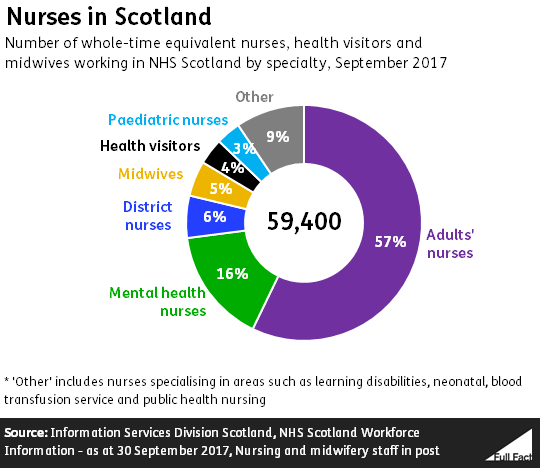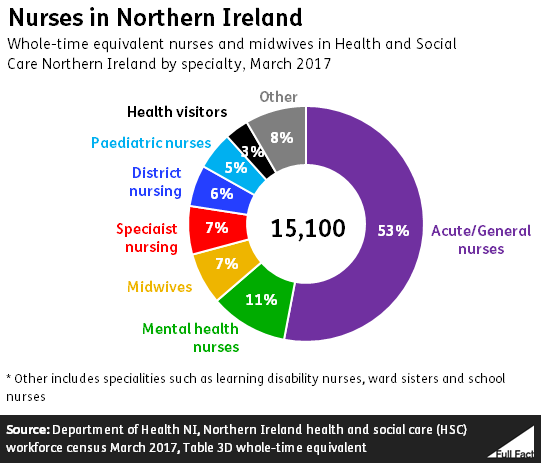The number of nurses and midwives in the UK
Join 72,547 people who trust us to check the facts
Subscribe to get weekly updates on politics, immigration, health and more.
Nurses and midwives in England
There were 287,100 full-time equivalent nurses and health visitors working in hospitals and community health services in NHS England in October 2017. There were also 21,900 midwives.
Full-time equivalent is the number of staff there would be if you added together all their hours to create only full-time jobs. So for example two people working half a week each would add up to one full-time equivalent job.

Claims are often made about the change in the number of nurses working in the NHS since the Coalition government entered office in 2010.
The number of full-time equivalent nurses and health visitors has increased by around 5,700 since October 2010, after initially falling in 2011 and 2012. The number of midwives has increased by 2,300 over the same period.

Not all types of nurses have increased in number though. There are around 5,700 fewer full-time equivalent nurses working in community health since October 2010 and 4,200 fewer working in mental health.
It’s been estimated by the Royal College of Nursing that there are around 40,000 vacant nursing positions in England (as of December 2016). That isn’t the same as the number of nurses NHS England needs, it’s the estimated number of vacant posts it has funding for.
NHS England doesn’t publish figures on the number of vacancies it has, but does publish experimental figures on the number of job adverts it puts out. We’ve looked at this and vacancy figures across the UK in more detail here.
Nurses on our wards
The government has made a number of claims about the number of nurses “on our wards” increasing. But when it says this it isn’t quoting numbers for all nurses. It’s referring specifically to nurses working on acute, elderly and general wards for adults in England.
These nurses make up the majority of nursing posts in the NHS, but they don’t represent all nurses who work on wards.
These nurses on acute, elderly and general wards accounted for 62% of all nurses and health visitors working in hospitals and community health services in England—as of October 2017. There are around 13,600 more full-time equivalent nurses working in these types of wards than in October 2010.
Those figures don’t include nurses who work in other areas, for example in mental health, paediatrics and maternity care. They won’t be included in this number even though some will work on wards.
We don’t have figures for the number of nurses on all hospital wards specifically.
Nurses working in other areas
Nurses also work in other sectors of healthcare. There were more than 15,500 full-time equivalent nurses working in GP practices across England in March 2017. That’s fallen slightly since the year before.
At the same time there were over 11,200 full-time equivalent nurses and health visitors working in independent sector healthcare – many of whom are commissioned to provide services for the NHS. Because of issues with the way this data is collected NHS Digital, which publishes the figures, say they shouldn’t be compared with other types of nurses.
Nurses in Scotland
There were just over 59,400 full-time equivalent nurses and midwives working in NHS Scotland as of September 2017. That’s an increase of around 250 compared to the year before.

The number of nurses and midwives in NHS Scotland has increased by around 6,200 since September 2002, the earliest figures we have. The numbers have generally been increasing but there was a dip between 2009 and 2012.

Outside of hospitals and community health services there were around 1,500 full-time equivalent nurses working in GP surgeries in Scotland as of August 2015. These are the latest figures available. The number of nurses working in GP surgeries had increased slightly since 2013 when a census of the GP workforce was conducted before that.
Nurses in Northern Ireland
There were 14,900 full-time equivalent nurses and midwives working in Health and Social Care Northern Ireland (the equivalent of the NHS there) in September 2017, the latest figures.
The number of nurses and midwives has increased by around 1,200 over the last ten years (comparing figures for March each year which go back further and give a more detailed breakdown).


There were around 540 full-time equivalent nurses working in GP practices in Northern Ireland in early 2016. This figure isn’t certain as it was based on a survey of practices that only 54% responded to.
Nurses in Wales
In 2016 there were 29,400 full-time equivalent staff working in nursing, midwifery and health visiting in NHS Wales. That’s an increase of about 1,200 since 2009.


Around 1,300 nurses were working in GP surgeries across Wales as of September 2016. That figure refers to the number of individual nurses though, rather than the full-time equivalent figure.
Registered nurses and midwives
In order to work in the UK, nurses and midwives must be registered with the Nursing and Midwifery Council (NMC). These nurses and midwives can be working in the NHS (in any of the four countries in the UK), the independent sector or perhaps not even working in the profession at all.
The number of nurses and midwives registered in the UK with the NMC decreased by nearly 1,700 between September 2016 and September 2017. The register went from having 691,400 nurses and midwives on it, to 689,700 over that time.
The figures aren’t a fair comparison though and might understate the fall in nurses registered.
Changes in how nurses and midwives from the UK register with the NMC meant an unusually high number were registered in September 2017 than in previous years. Around 4,000 people who would otherwise had to wait until October to have their application processed, joined the NMC in September. As a result the NMC said that it expected the number of registrations from the UK in October to be lower than in previous years.
Overall, more than 35,000 nurses and midwives left the NMC’s register between September 2016 and 2017.
The decreasing numbers on the register represents a shift from the trend in recent years. Between September 2013 and September 2016 the number on the register increased by just over 19,000.
Nurses and midwives from around the world
The trend in the number of people on the register varies depending on where they registered from. The number of people registered, who originally registered from the UK, stayed roughly the same over the 12 months to September 2017 (around 586,000 people). If the changes to registration time hadn’t been made the number is likely to have fallen.
The number of nurses and midwives on the register from the EEA also fell by around 2,700 over the same time – these figures weren’t affected by the change in registration practices.
By contrast the number of nurses and midwives on the register from the rest of the world rose slightly. The numbers from the rest of the world have remained fairly steady between 66,000 and 68,000 over the last five years.
An NMC survey from last year found that the top reason for leaving the profession was retirement. After that the most common reasons were: workload, personal circumstances and “disillusionment with the quality of care provided to patients”. The survey might not be representative of all nurses and midwives though and we’ve looked at it in more detail here.
The NMC couldn’t tell us how the numbers of nurses and midwives it has registered relates to the numbers working for the NHS. It told us it doesn’t collect this information.